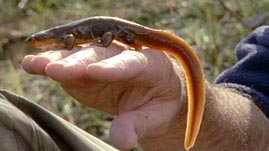Evolutionary history is filled with "arms race" relationships between organisms locked in struggles of adaptation and escalation. This is an example of coevolution. Usually, we think of a population that adapts to changes in a physical environment. Often, however, the pressure to adapt comes from another organism. It can occur between species that are predator and prey, competitors, or even between organisms linked by mutually beneficial symbiosis.
One well-documented example of an arms race adaptation is the potent poison in the skin of the newt
Taricha granulosa, which is food for the garter snake. Over time, some genetic variants of the snake that are resistant to the toxin have emerged -- and variants of the newt have become more poisonous. Yet another example is a species of snake that feeds on slugs. Some of the slugs have evolved a stickiness that makes them hard for the snake to swallow. There are, of course, structural and ecological limitations on just how much escalation can occur.
As with human arms races, the competition between coevolving organisms can have different outcomes. Sometimes the predator reduces the prey population to such low levels that not enough of the predator species can survive to maintain their population -- there is a critical minimum number of organisms needed for a species to survive. Quite often, however, predator and prey coexist with one another in a balance of nature that is subtle and built on their interdependence.


 Loading Standards
Loading Standards Teachers' Domain is proud to be a Pathways portal to the National Science Digital Library.
Teachers' Domain is proud to be a Pathways portal to the National Science Digital Library.
